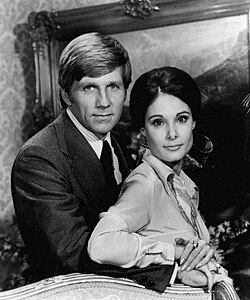The Sixth Sense (TV series)
| The Sixth Sense | |
|---|---|
 |
|
| Genre | Drama/Mystery/Thriller |
| Created by | Anthony Lawrence |
| Written by | John W. Bloch Don Ingalls Anthony Lawrence Robert Specht Ed Waters |
| Directed by |
Jeff Corey Alan Crosland, Jr. Robert Day Alf Kjellin John Newland Sutton Roley Barry Shear |
| Starring |
Gary Collins Catherine Ferrar Percy Rodriguez |
| Composer(s) |
Billy Goldenberg Robert Prince David Shire |
| Country of origin |
|
| Original language(s) | English |
| No. of seasons | 2 |
| No. of episodes | 25 |
| Production | |
| Producer(s) | Stanley Shpetner |
| Cinematography | Enzo A. Martinelli |
| Running time | 60 mins. (approx) |
| Release | |
| Original network | ABC |
| Audio format | Monaural |
| Original release | January 15 – December 23, 1972 |
The Sixth Sense is an American paranormal thriller television series featuring Gary Collins and Catherine Ferrar. Based on the 1971 television movie Sweet, Sweet Rachel, the series was produced by and (largely filmed at) Universal Studios, and broadcast by ABC from January 15 to December 23, 1972.
Dr. Michael Rhodes (Collins), a professor of parapsychology, with his assistant Nancy Murphy (Ferrar), attempts to solve supernatural crimes and mysteries.
The series, which was broadcast during Saturday nights at 10 pm, had tough competition from CBS's Mission: Impossible and NBC's Banyon. Despite mediocre ratings, The Sixth Sense was renewed for a second season, mainly due to its well-known guest stars. Ratings continued to decline, and ABC canceled The Sixth Sense on November 14, 1972, broadcasting the remaining episodes through December 1972.
Notable among its many guest stars were Joan Crawford, Sandra Dee, Patty Duke, Cloris Leachman, Carol Lynley, Lee Majors, William Shatner, Jane Wyman and Jim Davis.
For its syndication release, The Sixth Sense was edited and included with Night Gallery hosted by Rod Serling. As The Sixth Sense was an hour-long show, and the syndicated version of Night Gallery was a half-hour show, the episodes were edited quite severely. Serling's newly added introductions usually covered the introductory scenes and plot point set-ups that had been removed.
...
Wikipedia
